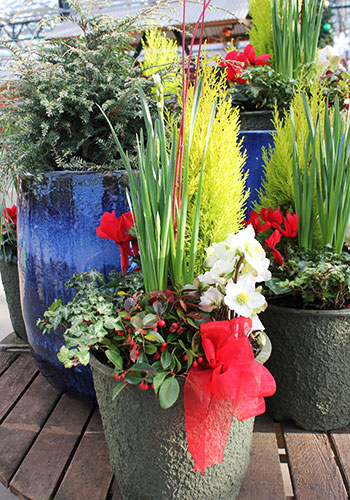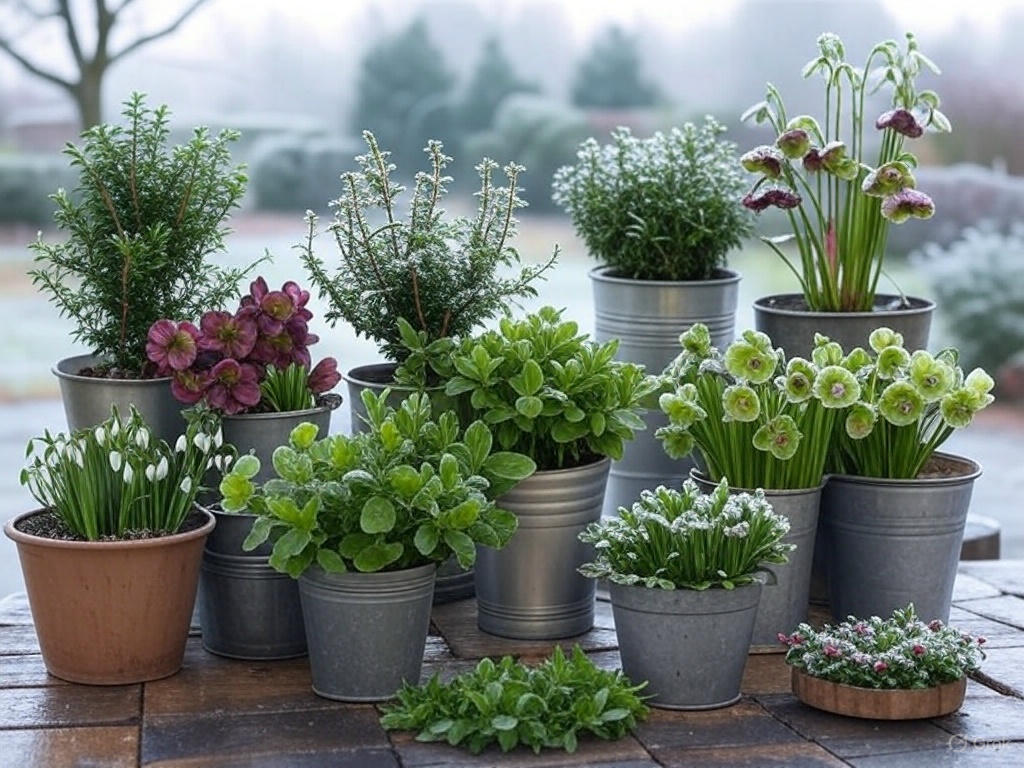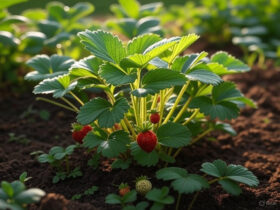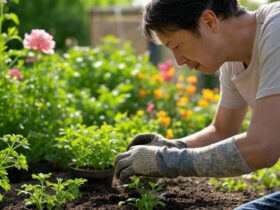Winter can be harsh on plants, but not all greenery needs to hibernate. Outdoor container plants bring life and color to your garden even in the coldest months.
Choosing the right plants for winter can be tricky, but it’s not impossible. With a bit of planning, you can have a beautiful winter garden. In this post, we’ll explore some of the best outdoor container plants that thrive in cold weather.
You’ll discover how to keep your garden vibrant and healthy, even when the temperature drops. From hardy evergreens to winter-blooming flowers, these options will ensure that your outdoor space remains inviting all season long. Stay tuned to learn more about keeping your garden lively through winter!

Table of Contents
Choosing The Right Containers
Winter doesn’t mean you have to say goodbye to your garden. With outdoor container plants for winter, you can keep your space vibrant and colorful. Choosing the right containers is crucial for the health of your plants. Different materials, sizes, and drainage options can significantly affect their growth and survival. Let’s explore these factors in detail.
Material Matters
The material of your planting containers for winter plays a big role in their durability and insulation. Here are some common materials and their pros and cons:
- Terracotta: Looks beautiful and provides good insulation. However, it can crack in freezing temperatures.
- Plastic: Lightweight and inexpensive. It retains moisture well but might not offer the best insulation.
- Ceramic: Attractive and often frost-resistant. These containers can be heavy and expensive.
- Fiberglass: Durable and lightweight. It provides excellent insulation but can be pricey.
- Metal: Modern look and very durable. Metal containers can get very cold and heat up quickly.
Choosing the right material ensures your plants have the best environment to thrive during winter. Consider your local climate and the specific needs of the best plants for winter containers.
Size And Drainage
The size of your container is vital for the health of outdoor container plants for winter. A larger container provides more room for roots to grow and better insulation from the cold. Here are some key points to consider:
- Small Containers: Easy to move but offer less insulation. Suitable for smaller plants.
- Medium Containers: A good balance between mobility and insulation. Ideal for a variety of plants.
- Large Containers: Provide excellent insulation. However, they can be heavy and difficult to move.
Drainage is equally important. Without proper drainage, water can accumulate and freeze, damaging the roots. Ensure your container has drainage holes. You can also add a layer of gravel at the bottom for better drainage.
Here’s a quick table to summarize size and drainage considerations:
| Container Size | Insulation | Mobility |
|---|---|---|
| Small | Low | High |
| Medium | Moderate | Moderate |
| Large | High | Low |
By choosing the right size and ensuring good drainage, you give your best container plants for winter the best chance to flourish.

Best Plants For Winter
Looking to keep your garden lively during the colder months? Outdoor container plants for winter are a fantastic way to ensure your space remains vibrant, even when temperatures drop. Selecting the best plants for winter containers can be a delightful experience, offering color and texture when most plants have gone dormant. Let’s explore some top choices that thrive in winter.
Evergreens
Evergreens are a popular choice for winter containers, providing year-round color and structure. They are resilient and can withstand harsh winter conditions, making them one of the best container plants for winter.
Here are some top evergreen options:
- Boxwood: Boxwoods are hardy shrubs that maintain their lush green foliage throughout the winter. They can be pruned into various shapes, adding a touch of elegance to your containers.
- Holly: Holly plants are known for their glossy, dark green leaves and bright red berries. They bring a festive touch to any winter garden.
- Juniper: Junipers offer a range of textures and colors, from blue-green to silver. They are drought-tolerant and thrive in containers.
- Yew: Yews have soft, needle-like foliage and are very low-maintenance. They can tolerate both sun and shade, making them versatile for various container locations.
Evergreens not only provide color but also serve as excellent backdrops for other plants. They are a reliable choice for anyone new to planting containers for winter.
Winter Blooms
While evergreens offer consistency, winter-blooming plants bring bursts of color to your garden. Including these in your winter containers ensures a lively and dynamic display throughout the season.
Consider these winter blooms:
- Hellebores: Also known as Christmas Rose, Hellebores bloom in late winter with beautiful flowers ranging from white to deep purple. They are hardy and can thrive in shaded areas.
- Winter Jasmine: This plant produces bright yellow flowers on bare stems in winter. It’s a great way to introduce a splash of color to your containers.
- Camellias: Camellias are known for their stunning flowers which can appear in shades of pink, red, and white. They prefer partial shade and well-draining soil.
- Cyclamen: Cyclamen plants are perfect for adding vibrant pink, red, or white flowers to your winter containers. They thrive in cooler temperatures and partial shade.
These winter blooms are among the best container plants for winter, offering beauty and interest when most other plants are dormant. Combining evergreens with winter-blooming plants can create a stunning and resilient winter garden.
Preparing Plants For Cold
As winter approaches, it’s essential to prepare your outdoor container plants for the cold. This ensures they remain healthy and vibrant throughout the season. Preparing plants for cold weather involves several crucial steps. Two of the most important tasks are proper watering techniques and fertilization tips. These practices help maintain the health of your container plants for fall and winter.
Watering Techniques
Proper watering is vital for the health of outdoor container plants for winter. As temperatures drop, plants need less water. Yet, it’s crucial they don’t dry out completely.
Follow these watering techniques:
- Check soil moisture: Insert your finger about an inch into the soil. If it feels dry, it’s time to water.
- Water in the morning: This allows the soil to absorb moisture before temperatures drop at night.
- Avoid overwatering: Too much water can cause root rot. Ensure containers have drainage holes.
- Use mulch: A layer of mulch on top of the soil helps retain moisture and insulates plant roots.
In winter, water outdoor container plants sparingly. Always ensure the soil is slightly moist but not soggy.
Here’s a quick reference table for watering frequency based on temperature:
| Temperature Range | Watering Frequency |
|---|---|
| Above 50°F (10°C) | Once a week |
| 32°F – 50°F (0°C – 10°C) | Every 10-14 days |
| Below 32°F (0°C) | Every 2-3 weeks |
Fertilization Tips
Fertilizing outdoor container plants for winter requires a different approach. During the cold months, plants enter a dormant phase and need fewer nutrients.
Consider these fertilization tips:
- Reduce frequency: Fertilize sparingly, about once a month, to avoid overfeeding.
- Use slow-release fertilizers: These provide a steady supply of nutrients over time.
- Opt for balanced fertilizers: Choose a product with equal parts nitrogen, phosphorus, and potassium.
- Avoid high-nitrogen fertilizers: High nitrogen levels can promote new growth that is vulnerable to cold damage.
For best results, stop fertilizing outdoor container plants about six weeks before the first expected frost. This gives plants time to harden off and prepare for the cold.
Here’s a simple fertilization schedule for the best container plants for winter:
| Fertilization Period | Frequency |
|---|---|
| Early Fall | Every two weeks |
| Late Fall | Once a month |
| Winter | Every six weeks |
Following these tips ensures your planting containers for winter remain lush and healthy, providing beauty and greenery even in the coldest months.

Insulating Containers
When preparing outdoor container plants for winter, insulating containers is crucial. It helps protect the roots from freezing temperatures. The right insulation keeps the plants healthy and vibrant throughout the cold months. Here are some effective methods for insulating your planting containers for winter.
Using Mulch
Mulch is one of the simplest ways to insulate outdoor container plants for winter. It acts as a protective layer, trapping heat and reducing temperature fluctuations.
Here are some benefits of using mulch:
- Regulates soil temperature: Mulch helps maintain a consistent temperature around the plant roots.
- Prevents soil erosion: It keeps the soil intact during heavy rains and snow.
- Reduces water loss: Mulch minimizes evaporation, keeping the soil moist for longer periods.
Different types of mulch can be used, such as:
| Type | Benefits |
|---|---|
| Straw | Good insulation, biodegradable, and adds nutrients to the soil. |
| Wood Chips | Long-lasting, effective in temperature regulation, and aesthetically pleasing. |
| Leaves | Readily available, decomposes quickly, and enriches the soil. |
To use mulch effectively:
- Place a 2-3 inch layer of mulch around the base of the plant.
- Ensure the mulch does not touch the plant stem to prevent rot.
- Check the mulch periodically and add more if it compacts or blows away.
Wraps And Covers
Wraps and covers provide additional protection for the best plants for winter containers. They shield the plants from harsh winds, snow, and ice.
Some common materials for wrapping and covering include:
- Burlap: A breathable fabric that offers good insulation without suffocating the plant.
- Bubble Wrap: Provides excellent insulation and is easy to wrap around containers.
- Fleece Covers: Lightweight and provide a protective barrier against frost.
Steps to wrap and cover your best container plants for winter:
- Wrap the container with burlap or bubble wrap, securing it with twine or tape.
- Cover the plant with a fleece cover or burlap sack, ensuring it is not too tight.
- For added protection, place the wrapped container in a sheltered area, such as a porch or garage.
Check the wraps and covers regularly. Make sure they stay secure and undamaged throughout the winter.
Using wraps and covers, along with mulch, can ensure your container plants for fall and winter remain healthy. These methods help maintain optimal conditions for plant growth, even in the coldest weather.
Positioning For Protection
Outdoor container plants for winter can add life and color to your garden, even in the coldest months. Positioning for protection is crucial to ensure your plants thrive. Proper placement helps shield them from harsh weather, keeps them warm, and provides the right amount of sunlight. Below, we explore the best ways to position your winter container plants for optimal growth and survival.
Sunlight Requirements
Sunlight is essential for outdoor container plants for winter. Even though the sun’s intensity is lower in winter, plants still need light to photosynthesize. Here are some tips:
- South-facing positions: Position your containers where they will receive maximum sunlight. A south-facing spot is ideal.
- Avoid full shade: While some plants can tolerate low light, avoid placing your containers in complete shade.
- Morning light: Morning sunlight is less intense and can prevent frost damage.
Consider the sunlight needs of the best plants for winter containers:
| Plant Type | Sunlight Requirements |
|---|---|
| Winter Pansies | Full Sun to Partial Shade |
| Ornamental Kale | Full Sun |
| Heather | Full Sun |
By meeting the sunlight requirements, you ensure your container plants for fall and winter receive the energy they need to stay healthy and vibrant.
Sheltered Locations
Finding sheltered locations for your planting containers for winter is equally important. Protection from strong winds and extreme cold can make a big difference. Here are some strategies:
- Near walls or fences: These structures can act as windbreaks and provide additional warmth.
- Under eaves or overhangs: These spots can shield plants from heavy rain and snowfall.
- Group containers together: Clustering pots can create a microenvironment that retains heat.
Think about the types of shelter:
- Porches and patios: These areas often provide natural shelter and can be great for container plants.
- Greenhouses: A small greenhouse can protect your plants from the harshest weather.
- Cold frames: These are great for providing a controlled environment for your plants.
By choosing sheltered locations, you can help the best container plants for winter survive and thrive through the cold months. Remember, protection and proper placement are key to a successful winter garden.
Maintenance During Winter
Winter can be a challenging season for outdoor container plants. Cold temperatures, wind, and limited sunlight can stress plants. Proper maintenance during winter ensures your plants stay healthy. This guide will help you keep your outdoor container plants for winter in top shape.
Monitoring Health
Regularly checking the health of your outdoor container plants for winter is crucial. Inspect your plants at least once a week. Look for signs of stress such as yellowing leaves, wilting, or unusual spots.
Here are some tips to monitor plant health:
- Check soil moisture: Cold weather can dry out soil. Ensure the soil is moist but not waterlogged.
- Watch for pests: Winter can drive pests indoors. Check leaves and stems for signs of infestation.
- Inspect for disease: Fungal diseases thrive in damp conditions. Look for mold or mildew on leaves and soil.
Maintaining a healthy environment is key. Ensure your plants get enough light. If natural light is limited, consider using grow lights. Proper drainage in planting containers for winter is essential. Use containers with drainage holes to prevent root rot.

Pruning And Cleanup
Pruning and cleanup are vital for the health of the best container plants for winter. Prune dead or damaged branches. This prevents disease spread and encourages new growth.
Here are steps for effective pruning and cleanup:
- Remove dead foliage: Cut back any dead or yellowing leaves. This helps the plant focus energy on healthy parts.
- Trim excess growth: If the plant is too bushy, trim it back. This improves air circulation and light penetration.
- Clean the container: Remove debris from the soil surface. This prevents pests and diseases.
Keep tools clean and sharp. This ensures clean cuts and reduces plant stress. Using the right tools makes the job easier and more efficient.
Regular maintenance helps your container plants for fall and winter thrive. A little effort can make a big difference in plant health. Enjoy the beauty of your winter garden!
Frequently Asked Questions
What Plants Can You Put In Pots For Winter?
For winter pots, choose plants like pansies, violas, cyclamen, and hellebores. Evergreen shrubs like boxwood and heather are ideal.
What Are The Best Pots To Leave Outside In Winter?
The best pots for winter are made of frost-resistant materials like fiberglass, resin, and high-fired ceramic. These materials prevent cracking.
Can Outdoor Potted Plants Survive Winter?
Yes, outdoor potted plants can survive winter with proper care. Move them to sheltered areas, insulate pots, and reduce watering. Choose hardy plants for best results.
What Container Plants Are Good For Fall And Winter?
Pansies, ornamental kale, and cyclamen thrive in fall and winter. Consider heuchera, hellebores, and wintergreen for more color.
What Are The Best Outdoor Container Plants For Winter?
Pansies, violas, heather, and ornamental kale are excellent choices. They thrive in cold weather.
How Do I Protect Container Plants From Frost?
Move pots to a sheltered spot. Wrap containers with bubble wrap. Water plants well.
Conclusion
Choosing the right outdoor container plants for winter is essential. Hardy plants survive cold weather and keep your garden vibrant. Consider evergreens like junipers for year-round greenery. Add pansies for bursts of color. Remember to select containers that protect roots from freezing.
Water wisely, ensuring plants stay hydrated without getting soggy. Mulch helps insulate plant roots, offering extra protection. With careful planning, your winter garden can thrive. Enjoy the beauty of nature, even in chilly months. Embrace the challenge of winter gardening.
It’s rewarding and keeps your outdoor space lively all year round. Happy planting!












Leave a Reply